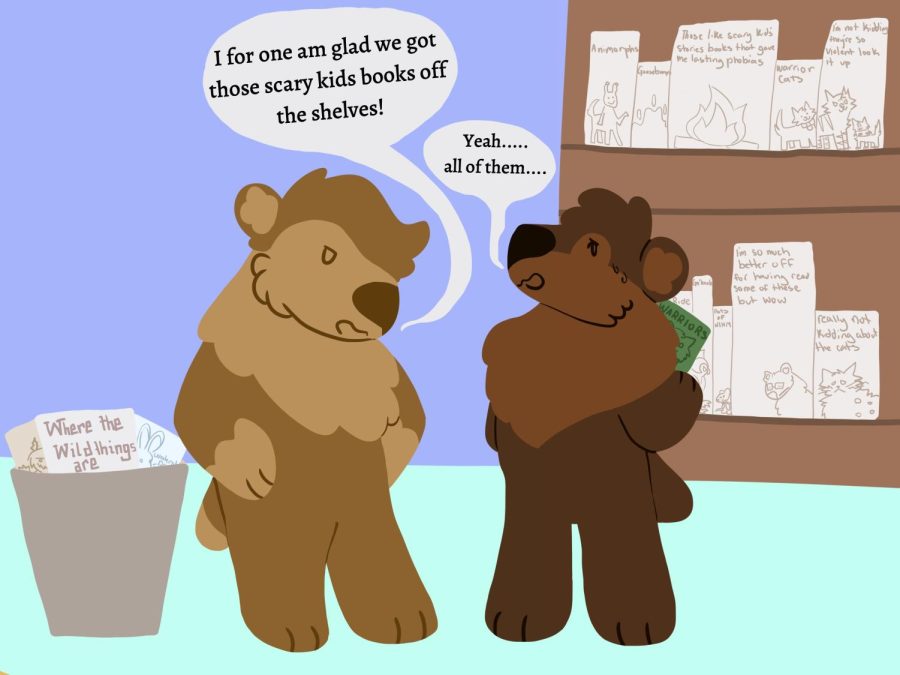Book bans more harmful than books
September 29, 2022
We all need to be scared from time to time. Without fear we are reckless, arrogant beings. Over the years, many pieces of literature have been criticized and even banned due to complaints of the content being too frightening for it to be suitable for children.
When I was a child there were many works that terrified me. I had to be taken out of the movie theater by my mom after witnessing half of Pixar’s “Brave.” Five minutes of “The Mask” was more than enough for me. These works filled me with trepidation and fear.
Yet nothing could bring forth that sense of absolute dread more than the children’s book “Where the Wild Things Are.” It is truly not an exaggeration to say that this book traumatized me for over a decade of my life. I could not go to sleep without the images of Max and his monsters thoroughly burned into my mind.Needless to say, it came as no surprise to me to find Maurice Sendak’s classic story at the top of most lists of banned books. However, what did surprise me was the reasoning behind these bans.
The singular aspect of “Where the Wild Things Are” that terrified me was the illustrations of the various monsters Max meets and eventually befriends – for a time at least. That is the one and only part of the book I would even come close to criticizing. When I was preparing to look over the grievances listed by parents who were in favor of banning the book, I expected to see that complaint at the top of the list.
I was met with something else entirely.
It seems that rather than taking any issue with the scary imagery, almost all the detractors found fault with one plot element of the tale. Toward the beginning of the book, Max is sent to bed without dinner after he has been particularly naughty – although “naughty” may be underselling it if I’m being honest.
When the book was released in 1963, this aspect of the story upset quite a few parents, particularly in the South. Said parents rallied to have the book banned from all of their public libraries and were often successful in these endeavors.
At the forefront of this “movement” was Bruno Bettelheim, an Austrian-born child psychologist, who was able to grant the critics of the book some legitimacy with his frequent objections to it on both scientific and moral grounds.
For years after the books publishing, and subsequent immense popularity with children and schoolteachers, Bettelheim prattled on and on about the supposed terror that was being implanted directly into the minds of children by the very notion of being sent to bed without supper.
Bettelheim took even more issue with the fact that Max’s mother was responsible for this abuse. Bettelheim’s profession combined with the angry voices of a number of parents formed a formidable force in opposition to the children’s book. Largely due to their efforts, “Where the Wild Things Are” has remained one of the most banned children’s books to this day.
Certainly, there were other criticisms. Some parents found the more supernatural elements of the tale to be distasteful, while others were, as I was, disturbed by the illustrations. Nevertheless, Sendak’s cautionary tale was primarily being banned over one tiny plot thread in a larger story.
Now to put a shift in perspective on the situation surrounding this book, I will point out that whatever criticism was levied against it has always been outweighed by heavy praise.
“Where the Wild Things Are” is one of the most celebrated children’s books on library shelves and in bookcases, having secured the Caldecott Medal in 1964.
Despite the banning efforts of a substantial number of people, the book has only increased in popularity since its release, even receiving a theatrical film adaptation in 2009. Now that I am older and hopefully wiser, I see the book for what it is: very thoughtful and well-written cautionary tale. Max’s story provides an excellent message to children.
That message would hardly possess the same sticking power without the scarier elements of the story
I do not regret having experienced the book as a child, and neither do hardly any people who grew up with the story. “Where the Wild Things Are” and other books like it are not harmful, nor do they pose a threat to children.
They provide a good lesson for children to learn, with the occasional frightening image to ensure that lesson is thoroughly learned.



